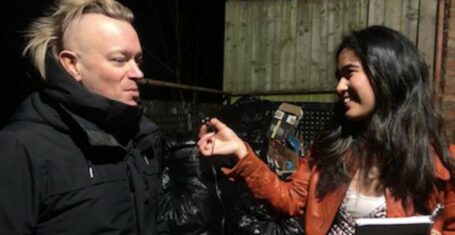
REVIEWED: THE HEAPS
‘vivid theatrical experience’
Set in the Norman Chapel, with the audience watching the performance from four rectangular sides, ‘The Heaps’ written and directed by Joe Skelton is a vivid theatrical experience. The Chapel is literally turned into a slum. There’s rubbish everywhere; plastic bags, bottles, containers, food leftovers, trolleys and trash cans. In the midst of that, we have Kaleep (Tim Blore) meeting Blanky (Hebe Beardsall). They are later joined by the rest of the Kaleep’s gang, initiating the girl into their game of trading the ‘treasures’ they find.
The first striking element of the show is its constant movement. The characters continuously relocate around the performance space by running and jumping. The speed of the performance complements the child-like vitality of the characters. They are thrilled to find an old pillow or notebook and react with childish fascination. As much as physicality plays a significant role in this production, the dialogue and the sounds flawlessly accompany the movement. The discourse resembles each character’s actions in rhythm and with the slight echo of the Chapel produces an enchanting effect. Both Tim Blore and Hebe Beardsall master this and as two characters opening the show, succeed in grasping the audience’s attention until the very end.
As the plot develops, we are exposed to the gang’s hierarchical order and a ‘Lord of the Flies’ similarity is brought to forefront. Reaching its climax when the Blanky is tied down for stealing the flower, the play is carefully structured. Affecting the audience’s physical involvement in the production using Artaudian techniques is a definite highlight of the show. Firstly, this is done by lighting effects. Throughout the first half we are presented with a set of fairy lights, delicately illuminated the stage space. The next half is entirely lit by actors themselves, using flashlights, which effectively follow and emphasise their movement. Secondly, the piece involves the audience physically by using sounds. The various exclamations of laughter, surprise and anger by the characters are enhanced with rattling rubbish, clattering spoons and jangling of the rubbish can.
Despite being set in a slum, the play actually touches upon the senses. Kaleep and Blanky respectively swear on their ability to see and hear. The stench of the place is constantly referenced and the crucial point of the play happens when the characters set their eyes on something more beautiful than anything they have seen before. At the outset, the piece has an animalistic feel to it with scavengers searching for treasures like animals hunting for prey. Gradually though, the ceremony of exchanging the objects found, with its incantations and refrains, becomes truly magical. This is especially well done by Three (Ruby Lawrence), during her monologue with the glowing red flashlight. The rhyming incantation, at times in complete darkness, becomes unnervingly sinister and establishes a great anticipation for the show’s ending.
Portraying a destitute squalor, the show manages to somehow be actually about stealing beauty and the significance of the visual allure. The whole spectacle leaves the audience in bewilderment, but overall lacks the ability to shock, which with the strong emphasis on the physical it definitely has a potential of doing. The symbolism employed was also excessive at times. Using the hair dryer as an instrument of terror was taken a bit too far. Nonetheless, the piece creates a beautiful allegorical illusion and its imaginary world is quite convincing.









































